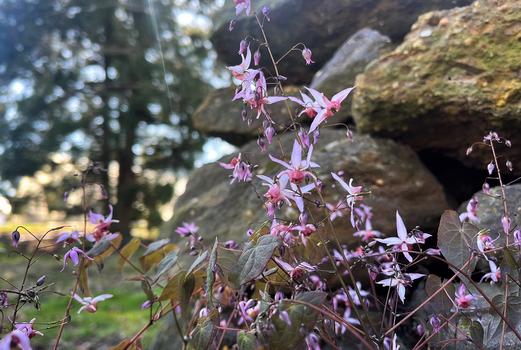The Ethereal Epimedium
Huddled together in the shade of the early morning, our collection of Epimedium greets the cool air with its upright, misty sprays of spidery looking flowers. This somewhat diminutive, slow-spreading groundcover is a plant collector’s dream. Under the Epimedium umbrella exists approximately 58 species, with the heart or arrow shaped leaves and ghostly blooms presenting themselves in an array of colors, shapes, and sizes. One could enthusiastically collect Epimedium varieties over the course of a lifetime and fill a shade garden with an impressive assemblage. Our ever-expanding selection of Epimedium here at the Nursery is simply the tip of the Epimedium iceberg.
The genus is known by a plethora of common names, most notably referred to as Barrenwort, Bishop’s Hat, Fairy Wings, and Horny Goat Weed for its aphrodisiac qualities (but more on that in a minute). They are often an unexpected delight in the shade garden due to their early bloom time and unique floral structures that vary widely in shape and color depending on the species form and color. Semi-evergreen to evergreen foliage also assumes an array of texture, color and shape variations. The combination of showy inflorescences atop various displays of foliage makes for a pleasant visual composition along the border of the shady cottage or specimen garden. There are two primary regions that Epimedium are endemic to – the Mediterranean basin, of which the species are usually evergreen and somewhat drought tolerant once established, as well as the Eastern Asia region, where the plants may die back to the ground in autumn and reappear in spring, preferring rich (but not overly saturated) soils and tending not to be drought tolerant. Epimedium species usually prefer rich, woodland-like soils with great drainage and protection from the sun, making them a lovely compliment to wood ferns and spring-blooming hellebores in the shady cottage garden.
Besides being a shade-loving spring spectacle, Barrenwort species are known for being potent medicinal herbs and have significant history in Traditional Chinese Medicine. In fact, there have been innumerable studies regarding the phytochemical constituents that have been touted as medicinally beneficial for decades, and it turns out that traditional herbalists were right about a lot – both in vitro and in vivo trials have confirmed that the Epimedium genus shows activity against conditions such as osteoporosis, menstrual irregularity, and sexual dysfunction, all the while improving cardiovascular, immunological and cerebrovascular functions. Species within the Epimedium genus have also shown anti-tumor and anti-aging effects, with one study showing that an extract made from the leaves of Epimedium brevicornum has the potential to inhibit the growth of breast cancer cells due to the plant’s estrogenic qualities. That being said, it is generally recommended that individuals with serious cardiovascular diseases or those who are hormone-sensitive avoid utilizing Barrenwort because of its ability to affect hormone levels.
Our current offering of Epimediums includes the following: Epimedium spp. Spine Tingler, Epimedium wushanense ‘Sandy Claws’, and hybrids ‘Amber Queen’, ‘Domino’, ‘Pink Elf’ and ‘Songbirds’, with future crops of Epimedium grandiflorum ‘Pretty in Pink’, ‘Purple Pixie’, and ‘Rose Queen’, Epimedium x perralchicum ‘Frohnleiten’, Epimedium x rubrum, Epimedium x versicolor ‘Sulphureum’, and Epimedium x warleyense ‘Ellen Willmott’ and ‘Orange Queen’ expected to be ready by mid-to-late spring. Check out our availability and add them to your next order to help continue the legacy of this special plant!
BBC Gardener's World Magazine. “How to Grow Epimediums.” How to Grow Epimediums. BBC Gardeners World Magazine, March 8, 2023. https://www.gardenersworld.com/how-to/grow-plants/epimediums-grow-guide/.
DiPaulo, Carolyn. “EPIMEDIUMS, My Collection.” CAROLYN'S SHADE GARDENS, June 26, 2017. https://carolynsshadegardens.com/2013/04/18/epimediums-my-collection/.
Ma, Huiping, Xirui He, Yan Yang, Maoxing Li, Dingjun Hao, and Zhengping Jia. “The Genus Epimedium: An Ethnopharmacological and Phytochemical Review.” Journal of Ethnopharmacology 134, no. 3 (2011): 519–41. https://doi.org/10.1016/j.jep.2011.01.001.
Memorial Sloan Kettering Cancer Center. Epimedium. Memorial Sloan Kettering Cancer Center, n.d.. https://www.mskcc.org/cancer-care/integrative-medicine/herbs/epimedium.
NC State Extension. “Epimedium.” Epimedium (Barrenwort, Bishop's Hat, Epimedium, Fairy Wings) | North Carolina Extension Gardener Plant Toolbox. North Carolina State Extension Service | NC State University, n.d.. https://plants.ces.ncsu.edu/plants/epimedium/.
Puisis, Erica. “How to Grow and Care for Epimedium.” The Spruce. The Spruce, August 8, 2022. https://www.thespruce.com/epimedium-growing-guide-5211581.
Shen, P., B.L. Guo, Y. Gong, Deborah Y.Q. Hong, Y. Hong, and E.L. Yong. “Taxonomic, Genetic, Chemical and Estrogenic Characteristics of Epimedium Species.” Phytochemistry 68, no. 10 (2007): 1448–58. https://doi.org/10.1016/j.phytochem.2007.03.001.
Yap, Sook Peng, Ping Shen, Mark S. Butler, Yinhan Gong, Chong Jin Loy, and Eu Leong Yong. “New Estrogenic Prenylflavone fromEpimedium BrevicornumInhibits the Growth of Breast Cancer Cells.” Planta Medica 71, no. 2 (2005): 114–19. https://doi.org/10.1055/s-2005-837776.
See all our Perennials
Epimedium x Pink Elf






